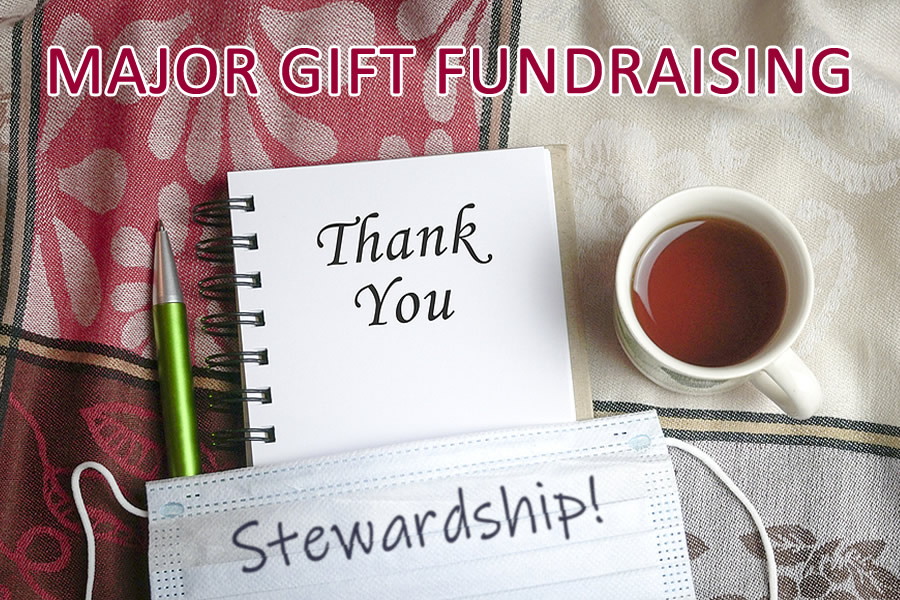
Stewardship is the fourth and final stage of the fundraising cycle. (Step 1 is Donor Identification, Step 2 is Cultivation and Step 3 is Solicitation.)
What is Stewardship?
Everything that happens after a gift is made is a part of stewardship. In other words, all forms of expressing gratitude and letting the donor know how their gift was used (AKA the impact they made).
Stewardship is arguably the most important part of the fundraising process because how it’s done could determine whether or not the next gift is made. In other words, if your donor doesn’t feel appreciated or understand that their gift made a difference, they are not likely to give again.
Two Key Components of Your Stewardship Plan
Two key components of stewardship include:
1. Personalized Gratitude
The primary goal of stewardship is to make sure your donor feels thanked. Please note, that’s different from simply thanking your donor. The idea is to ensure they FEEL thanked (not only that they are thanked)! Ask yourself:
Do my donors feel the love after they receive our standard thank you letter?
What are you doing to ensure your donors FEEL thanked? Here are some suggestions:
- Personalized notes
- Calls from respected individuals (CEO/ED, Board Members)
- Individualized video (nothing fancy, just taken on your phone)
- Small tokens of appreciation
- Notes or drawings by clients
Do your stewardship efforts stand out? If a donor gives to 10 charities, how is your thank you different from every other thank you letter? Is it something they would keep or would they toss it right into the trash? Make it personal and memorable.
Gratitude can be expressed by multiple people in more than one way. For example:
- A board member can make a phone call
- The Executive Director can handwrite a note
- The Development Director can send an email
- A client can send a letter or picture
2. Reporting Impact
Another important aspect of stewardship is reporting impact. Does your donor know how their gift was used and the how it made a difference? Do they feel your organization truly needs and values their contribution?
For major donors (those you asked in-person or over Zoom in a one-on-one setting), you should report impact in the same, personal way. Think about these two questions:
- What would happen if your donor didn’t give?
- What happened BECAUSE your donor DID give?
Make sure you express the answers to these questions when you follow up with your donor down the road.
When Should You Report Impact?
Several months after showing your gratitude for the gift, you’ll want to report back to your donor. Ask for another meeting to provide an update about the programs and services the donor-supported. After your visit or virtual meeting, send one more follow-up note (email or letter) to reiterate what you discussed in person.
How COVID Has Changed Stewardship
When it comes to raising major gifts, the general concepts of stewardship have remained the same throughout the pandemic. That is, you should express gratitude and report back to donors. However, the pandemic has invited creativity and ingenuity into the process and there’s no reason to that can’t persist beyond COVID.
Creative Stewardship
A common way to steward donors before the pandemic was to take them out to lunch. Of course, that was not an option for many months, so nonprofit leaders needed to get imaginative.
For example, a soup kitchen and culinary school I donate to mailed me cookies that clients baked. What a yummy treat! (And one that I haven’t forgotten.)
Leveraging Technology
Leveraging technology is another socially-distanced way to express gratitude that will continue beyond the pandemic. Use your smartphone and video chat to connect clients and donors (when appropriate), or film people at your organization expressing gratitude to a specific donor.
As we head into the second winter of COVID, people will be more eager than ever to connect. Think outside the box and drop something meaningful on their doorstep or stop by with a socially-distanced message.
What are some other ways you can think of to engage in creative and technological stewardship? Share your ideas in the comments below.

Thank you for highlghting the importance of properly done thank you messages to donors. I have always done hand written personalize notes and it has been one of the tools of success in my major gift fundraising career for over 25 years.
Recently, I was criticized by the Executive Director of a small nonprofit for not sending out typed business like thank you letters. I was thanked by donors for my thank you notes. The difference of opinion between Executive Director and me caused me to resign as I could not work with someone who did not understand the basics of donor relationships. The organization will not get the recurring gives that I stewarded for several years.
I break donor relations into three parts – Acknowledgement (the grateful thank you), recognition (telling others about the gift), and stewardship (reporting on gift’s impact). It helps me to understand that all three processes are important to the relationship with the donor and to getting the next gift.